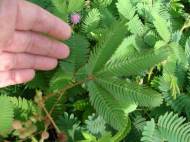Mimosa biomimicry inspires new adaptive structures
 Researchers at University of Michigan (U-M) and Penn State University are studying how plants like the Mimosa can change shape, and they’re working to replicate the mechanisms with artificial cells. Currently, their artificial cells are palm-size and larger, but they’re trying to minify them by using microstructures and nanofibers to construct them. They’re also exploring how to replicate the mechanisms by which plants heal themselves.
Researchers at University of Michigan (U-M) and Penn State University are studying how plants like the Mimosa can change shape, and they’re working to replicate the mechanisms with artificial cells. Currently, their artificial cells are palm-size and larger, but they’re trying to minify them by using microstructures and nanofibers to construct them. They’re also exploring how to replicate the mechanisms by which plants heal themselves.
“This is quite different from other traditional adaptive materials approaches”, said Kon-Well Wang, Mechanical engineering professor at U-M. “In general, people use solid-state materials to make adaptive structures. This is really a unique concept inspired by biology.”
The Mimosa is among the plant varieties that exhibit specialized “nastic motions” – movements noticeable in real time with the naked eye. Its capability to fold its leaves when touched is inspiring a new class of adaptive structures designed to twist, bend, stiffen and even heal themselves. The phenomenon is made possible by osmosis (the flow of water in and out of plants’ cells) which enables the plant to fill or empty some of its cells with water. These microscopic shifts allow the plants to move and change shape on a larger scale.
“We know that plants can deform with large actuation through this pumping action”, said Wang. “This and several other characteristics of plant cells and cell walls have inspired us to initiate ideas that could concurrently realize many of the features that we want to achieve for adaptive structures.”
Erik Nielsen, assistant professor in the U-M Department of Molecular, Cellular and Developmental Biology, believes nastic movements might be a good place to start trying to replicate plant motions because they don’t require new growth or a reorganization of cells.
“These rapid, nastic motions are based on cells and tissues that are already there”, said Nielsen. “It’s easy for a plant to build new cells and tissues during growth, but it’s not as easy to engineer an object or machine to completely change the way it’s organized. We hope studying these motions can inform us about how to make efficient adaptive materials that display some of the same types of flexibility that we see in biological systems.”
At U-M, Michael Mayer, associate professor in the departments of Biomedical Engineering and Chemical Engineering, is also involved in the research. At Penn State, the project involves Charles Bakis, distinguished professor of engineering sciences and mechanics, and Christopher Rahn, professor of mechanical engineering.
When this technology matures, it could be used for shape-shifting robots which could change their shape into elephant trunks or snakes to maneuver under a bridge or through a tunnel, and then turn into something less flexible in order to grab or carry something. The researchers also believe it could be used for future morphing wings that would allow airplanes to behave more like birds by changing their wing shape and stiffness in response to their environment or the task at hand.









Biomimicry at its best in structures.
In this connection traditional methods of construction in vogue in the past in Andhra Pradesh, India are worth looking into.
In Andhra Pradesh(Some parts) people used to make bamboo frames(just like iron rod frames) for making structure to make almairahs. Bamboo’s tensile strength is equal to that of steel and it bends easily.
Also in Kenya Sisal agave plant is chopped into pieces, dried and mixed in concrete. Sisal fibre is very strong and ropes are made with it.
Also in Andhra Pradesh(India) in the earlier days in the roof construction wooden bars were used and in place where they go in the wall that portion was wrapped with a leaf called Moduga in Telugu. I saw in a demolished house after 100 years the Moduga Leaves were in tact.
Traditional methods of construction need to be revived giving a modern refinement.
Dr.A.Jagadeesh Nellore (AP), India
Excellnt idea.
We have two little sensitive plants at home and when I saw their response to touch, I was wondering if it is possible to design such adaptive structures to withstand shock loadings (sesimic etc). Then I googed and came across this news.
Best wishes to Michigan and PennState colleagues.
Sinniah Ilanko